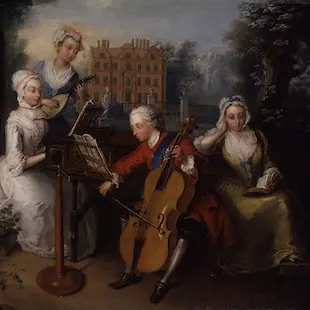Major and Minor Chords
Learn all about major and minor chords, including how to play them and identify them in a piece of music.
Last updated on 7 June 2024
Major and minor chords are the building blocks of music in the Western European tradition, and the starting point of harmony and chord progressions in almost all genres.
But what’s the difference between major and minor chords?
The first difference is technical: how you play them. The second is human: how the chords “sound” to us as listeners.
Here's what you'll learn in this article:
- How to play major and minor chords on piano
- How major and minor chords sound
- Why they sound different
- Songs featuring major and minor chords
- How to identify and use relative major and minor chords
Understanding major and minor chords is an excellent step towards growing as a piano player: Not only will you be able to learn songs faster, but you'll be able to discover and create new melodies on your own, too. Let's dive in!
Major chords
How do you play major chords on piano?
If you’re familiar with scales, you might know that most scales have seven notes — on the eighth note, the scale starts again an octave higher (see our Beginner's Guide to Learning Piano for more on this).
This is a major scale — C major, to be specific:
A major chord is built from a major scale. It can have three or more notes, but we'll focus on three-note chords — known as triads — here.
Major triads have a root note, a middle note, known as the third, and a top note, known as the fifth. You can easily find the three notes of a major chord from a major scale. The root note is the first note of the scale. The third and the fifth notes of the chord come from the third and the fifth notes of the scale.
If you don't know the major scales, no worries! You can easily build a major chord by knowing the distance between the three notes. There are three piano keys between the root and the third, and two piano keys between the third and the fifth. This spacing between the root, middle and fifth is always the same, no matter which root note you start on.
As an example, to build a C major triad, start with C as your root note. Then, skip over three keys (black and white) to E, which is the third. From there, skip over two more keys to G, the fifth of the chord. So, a C major triad consists of C, E and G.
Here's how it looks and sounds to play a C major triad with your right hand:
Minor chords
How do you play minor chords on piano?
Let’s go back to scales again, but this time we'll look at a minor scale. To build a minor chord from a minor scale, you just pick out the first, third and fifth notes of the scale and voila! However, even if you don't know the minor scales, you can still build a minor triad from a major triad.
Once you know how to build a major triad, it's really easy to make a minor triad from it. All you need to do is move the middle note, or third, of the major scale down one piano key. That's it!
So, instead of having three keys between the root and third and two keys between the third and fifth, as is the case with the major triad, the distance is reversed: For minor triads, there are two keys between the root and third and three keys between the third and fifth.
Continuing from the example above, the C minor triad has C, E♭ and G.
And just like with the major triad earlier, to play this minor triad, place your first, third and fifth fingers on the first, third and fifth notes, respectively. Here's how it looks and sounds:
What do major and minor chords sound like?
Major and minor chords will create different impressions depending on the listener's cultural background. For the purposes of this article, we're focused on the impact major and minor chords have on listeners accustomed to music in the Western European tradition.
With that said, let's begin with major chords. Here, the descriptions you'll find generally point to the music's uplifting effect, with words like happy or bright.
Minor chords, on the other hand, are often described as more pensive, melancholic or dark.
Why is this? Some people have suggested a scientific cause — for example, that the actual sound waves of major and minor chords produce different physical effects on the listener. But this theory is undermined by studies showing that in some cultures, minor chords are considered to be "happy" and major chords are considered to be "sad."
For those of us who associate minor chords with sadness, we can point to the ideas of consonance and dissonance, wherein major chords sound more harmonically stable, or consonant, while minor chords sound somewhat unresolved and ill-matched (dissonant).
This is indeed a deep topic that you could spend hours digging into, so we'll leave it there for now, and let you explore the rabbit hole further on your own time if you so wish!
What songs are good examples of major and minor chords?
It’s very rare that a song or piece of music will use only major or only minor chords. Songs move naturally through a progression of chords that combine to create something more special than any single chord ever could. So, even sad songs can start with major chords, and happy songs can use a lot of minor chords.
Here are some examples that start with major and minor chords:
Songs starting with major chords
"Eine kleine Nachtmusik" — Wolfgang Amadeus Mozart
This is probably one of the most famous progressions of major chords in Classical music, bouncing with joy, lightness and positivity from the very first note.
"Imagine" — John Lennon
From possibly the most famous Classical piece in a major key to arguably the most famous song in pop music history… These simple major chords have been bringing a sense of hope to listeners for more than 50 years.
"Angels" — Robbie Williams
Sometimes, a pure love song needs pure positivity. This '90s hit stays with major chords all the way through the first verse, setting the tone for the uplifting sing-along.
Songs starting with minor chords
"Moonlight Sonata" (1st Movement) — Ludwig van Beethoven
If you want something to play while feeling sad and mournful, look no further than this minor-chord-centric masterpiece.
"Skinny Love" — Birdy
This version of the Bon Iver original opens with a scattered minor chord. The rest of the song moves through a simple progression that is often major, but never far from that first chord that sets the tone perfectly for a song soaked in heartbreak.
"All of Me" — John Legend
The minor chord that opens this tender ballad is a lesson in how to take a listener on a journey. It sounds sad and mournful, but when the chorus kicks in and goes major, it’s time to really take out the tissues.
What is a relative minor/major?
When the last song above ("All of Me" by John Legend) switches from a minor chord to major in the chorus, the transition has a particular sweetness to it. This is because those two chords — F minor and A♭ major — have a special relationship: F minor is the relative minor of A♭ major, and A♭ major is the relative major of F minor.
What this means is that the keys of F minor and A♭ major have exactly the same notes and key signature but simply start in different places — on the root notes of F and A♭, respectively.
How do you find the relative minor/major?
You may have noticed that the root note of the relative minor (F minor) above is three piano keys below the relative major (A♭ major). This is true in any key:
- If you have a major chord, go three piano keys down to find the relative minor.
- If you have a minor chord, go three piano keys up to find the relative major.
Why is the relative major/minor useful?
Understanding the relative major and minor chords on piano is useful for many reasons. If you're just starting out, it helps you recognize patterns and learn songs more quickly — whether you're learning from sheet music or an app like flowkey, or playing by ear. If you're improvising or composing your own songs, understanding relative chords will expand your ability to transition between chords and modulate the moods of your piece as you desire.
Once you've grasped the concept, you'll start to see them everywhere — and be a stronger piano player because of it!
Explore and learn more! Next steps and resources
With a solid understanding of major and minor chords, you're ready to dive deeper. Our chords library contains all the popular major and minor chords you could hope for, showing you how to play them in their root positions, plus first and second inversions.
You can also learn more about building, playing and improvising with chords in the flowkey app.
Happy playing!
Read next
Why Every Piano Beginner Should Learn Music Theory
Understanding the theory behind the music you play is key to becoming a better pianist. Here's why it's worth taking the time to learn the basics.
15 Easy Piano Songs for Beginners
Even beginners can play beautiful piano songs. We highlight 15 great, simple pieces—all available to learn with the flowkey app.
Piano Hands: How to Build Better Playing Technique
Having good technique on the piano helps you make progress faster in your practice, play with greater expression and control, and make you less prone to injury.
15 Great Pop Songs for Piano: Classics, Modern Hits and More
From Elvis Presley to Billie Eilish, we cover the best pop songs to learn on piano for all levels of player, whether you're a beginner or pro.







